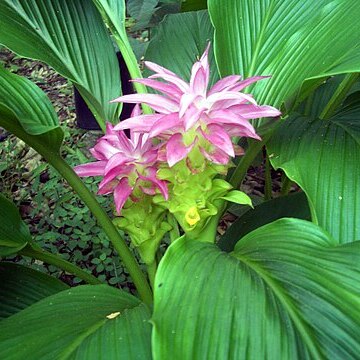Rhizome not elongating, yellow within. Leaves tufted; lamina ovate-lanceolate, acuminate, rounded at base, glabrous, to 45 cm long and 19 cm wide; petiole to 15 cm long. Inflorescence terminal, cylindrical, to 15 cm long, 3 cm wide; fertile bracts oblong, acute, recurved at tips, 1.5–2.5 cm long, green, each subtending a cincinnus of up to 5 flowers; sterile bracts longer, flushed rose. Flowers pale yellow, exserted from bracts; dorsal lobe of corolla broadly concave, 1.5–2 cm long. Lateral staminodes 1 cm long, not folded behind stamen. Labellum c. 1.5 cm long, ± orbicular, emarginate. Anther spurred at base.


